“The versatility of foam injection molding is evident in its wide range of applications. Industries such as automotive, aerospace, and consumer goods leverage this technology for its exceptional ability to produce strong and lighter parts.”

There are different injection molding methods to address the diverse manufacturing needs. Among many, foam injection molding is a testament to the versatility of injection molding technology. Unlike traditional methods, it introduces a unique element – cellular foam structure creation within molded parts. This distinctive approach not only reduces material usage but also enhances the structural integrity of the final product.
This article focuses on the various aspects of foam injection molding, exploring its processes, benefits, and applications.
What is Foam Injection Molding?
It’s an innovative variant of traditional injection molding that integrates a blowing agent into the polymer. This addition creates a cellular foam structure within molded components. The process results in lightweight yet strong parts. The central distinction of this injection molding lies in its material efficiency. It uses less raw material compared to standard injection moldings. This reduction is due to the foam’s expanded volume. As a result, the process is cost-effective.
Moreover, it allows for greater design flexibility. Designers can create complex shapes and large parts more efficiently. The process accommodates intricate designs that might be challenging with traditional methods. This flexibility opens up new possibilities in product design and innovation.
Read more: Six Injection Molding Types: Which One is the Best Option?
How does the Foam Molding Process Work
The foam molding process is grounded in a unique blend of chemistry and physics that involves creating a cellular structure within a polymer matrix using a blowing agent. Once the agent is activated, it induces a foaming reaction. Here, the polymer acts as the base material, providing the structural framework.
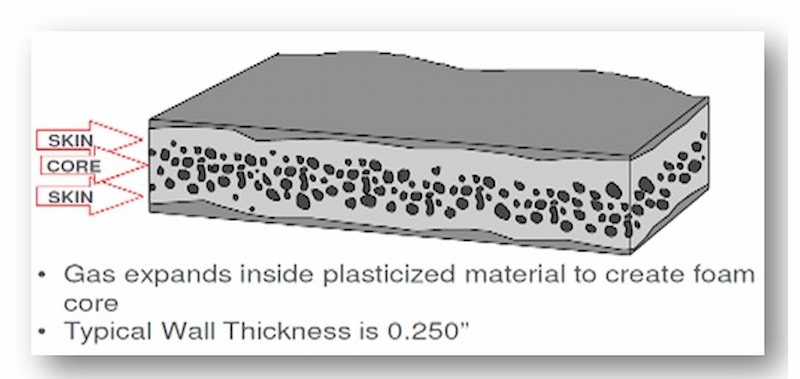
Foam molding structure
The blowing agent(either chemical or physical) is the key to creating the foam. This agent decomposes or vaporizes and releases gases when heating. These gases form tiny bubbles or cells within the molten polymer. As the molten polymer fills the mold cavity, it starts to cool. The bubbles stabilize during the cooling, forming a solid foam structure. This structure is unique, filled with numerous tiny uniformly distributed cells.
Related: 3D Printing Vs. Injection Molding: Choose the Best Method for Your Project
The Foam Injection Molding Process
Foam injection molding is a complex, multi-step process. It involves precise control over material, temperature, and pressure. This results in unique cellular structures within the molded parts.
Here, we break down each step of the foam injection molding process.
1. Material Preparation
Material preparation is the first critical step. You can select the appropriate polymer and blowing agent. The choice depends on the desired properties of the final product. Data on polymer-blowing agent compatibility guides this selection.
2. Mixing and Melting
Next, the polymer and blowing agent are mixed and fed into the injection molding machine. Here, controlled heating melts the mixture. The melting point varies with the polymer but remains a closely monitored parameter.
3. Blowing Agent Injection
Once the material reaches the correct temperature, the blowing agent is injected. The agent can be a physical or chemical. The choice of agent impacts the foam’s characteristics.
4. Injection into the Mold
The mixture is now foamy and injected into a pre-shaped mold. This step must be swift to prevent premature cooling. The mold design directly influences the part’s final dimensions and tolerances. For example, The over-flow cavity is also effective in further coring out the injected part produced via the fluid-assisted injection molding process. Source.
5. Foaming
Inside the mold, the blowing agent reacts. It creates a cellular structure by forming gas bubbles. This process is delicate, where the science of foaming comes into full effect. It’s pivotal for the end product’s quality.
6. Cooling and Solidification
After injection, the part cools within the mold. Cooling rate calibration is essential to ensure the foam solidifies correctly, maintaining the structure’s integrity.
7. Ejection and Post-Processing
Once solidified, the new part is ejected from the mold. It may undergo various post-processing steps. These can include trimming, painting, or assembly.
Try Prolean Now!
What are the Types of From Injection Molding?
Foam injection molding can be classified into various types based on the method used to create the foam within the polymer matrix. The primary methods include physical foaming, chemical foaming, and structural foaming. Each type employs different techniques and agents to introduce gas into the molten polymer, leading to the formation of a foamed structure.
Next, the type of foaming method can significantly influence the physical properties of the molded part, including its thermal insulation, sound absorption, and impact resistance.
Physical Foaming
Physical foaming involves the introduction of an inert gas, such as nitrogen or carbon dioxide, into the polymer melt under high pressure. As a result, the gas dissolves into the molten polymer.
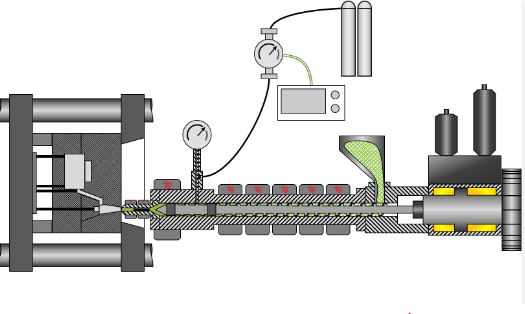
Physical foaming equipment
As the pressure is released during the injection into the mold, the gas comes out of the solution, forming bubbles within the material. The main advantage of physical foaming is that it does not rely on chemical reactions. Furthermore, it’s more environmentally friendly since it doesn’t produce additional chemical byproducts.
Chemical Foaming
Chemical foaming utilizes a chemical blowing agent that decomposes at elevated temperatures, releasing gases like nitrogen or carbon dioxide. This reaction occurs as the polymer is heated during the molding process. The gases form cells within the polymer upon cooling and solidification.
It can create a wide range of cell sizes, which can be controlled by the type and amount of blowing agent used. This method is beneficial for creating foamed parts with specific mechanical properties, such as improved impact resistance or thermal insulation.
Structural Foaming
The structural foaming method is another variant that produces parts with dense skin and a cellular core. This process typically uses a chemical foaming agent. Structural foam molding is relatively similar to standard chemical foaming. However, it operates at lower injection pressures.

Structural foaming
The lower pressure allows for the solid, non-foamed outer layer while the core becomes foamed due to gas expansion. The resulting parts have an increased stiffness-to-weight ratio due to the dense outer skin, which provides structural strength, while the foamed core reduces weight.
Which Materials are Compatible for Foam Injection Molding?
As there are various injection molding materials, foam injection molding is compatible with several materials, each offering unique properties for various applications. The process is versatile, accommodating both thermoset vs. thermoplastics, which can be tailored to meet specific performance criteria. However, thermoplastic foam injection molding is the most common.
Materials are chosen based on factors, such as strength, flexibility, thermal stability, and chemical resistance. The adaptability of the foam injection molding process allows for experimentation with different polymers to achieve the desired characteristics in the final product.
Materials compatible with foam injection molding include:
- Polyethylene (PE)
- Polypropylene (PP)
- Polystyrene (PS)
- Polycarbonate (PC)
- Polyamide (PA)
- Thermoplastic polyurethane (TPU)
- Acrylonitrile butadiene styrene (ABS)
- High-impact polystyrene (HIPS)
- Poly(methyl methacrylate) (PMMA)
- Polyphenylene oxide (PPO)
- Thermoplastic elastomers (TPEs)
- Polyurethane (PU)
Click here to download: Microcellular foam injection molding process
Try Prolean Now!
What are the Benefits of Foam Injection Molding?
It offers a strategic way to enhance product functionality while adhering to economic and ecological considerations. The ability to create complex shapes with improved material properties makes it a key player in innovative manufacturing.
Weight Reduction
One of the most significant advantages of foam injection molding is weight reduction. This advantage is particularly beneficial in the automotive and aerospace sectors, where every gram counts towards fuel efficiency and payload maximization. In consumer goods, lighter products translate to better ergonomics and usability. Moreover, lighter parts can lead to savings in shipping and logistics, reducing the overall cost of transportation.
Material Efficiency
Material efficiency is another advantage of foam injection molding. Less material is needed to produce parts that maintain their desired size and shape because of a foamed internal structure. It cuts down on raw materials and reduces production costs. Additionally, the process’s compatibility with recycled materials further underscores its sustainability.
Enhanced Structural Strength
Contrary to what one might expect, the reduction in material does not compromise the part’s strength. Foam injection molding imparts a high strength-to-weight ratio to components, making them sturdy and durable. It is valuable for parts that must bear loads or withstand impacts, such as in the automotive industry, where safety and durability are paramount.
Thermal and Acoustic Insulation
The insulative properties of foam injection molded parts are exceptional due to the air trapped within the foam cells. This characteristic makes them ideal for applications requiring thermal insulation, such as energy-efficient building materials or automotive components that must resist heat transfer. The same structure that retains heat also helps to dampen sound, making these components excellent for acoustic insulation.
Design Flexibility
The process allows complex shapes and intricate details that would be challenging or impossible to achieve with traditional solid materials. Designers can explore innovative geometries without worrying about the manufacturing limitations that often constrain creativity.
Cost-Effectiveness
From a financial perspective, foam injection molding is highly cost-effective. The process can reduce cycle times. Parts cool & solidify more quickly due to their reduced mass. Operational costs benefit from decreased energy requirements in terms of heating less material and often requiring lower clamping forces due to the lower injection pressures involved. Next, the mold material also influences the molding cost. For example, aluminum injection molds are less costly than mold made with. titanium alloys.
Foam Injection Molding Applications

Foam injection molded parts
Foam injection molding offers benefits like weight reduction, material efficiency, and structural integrity. The resulting lightweight strong components have a broad range of applications, making this technology vital in numerous industries.
It creates cost-effective parts that boast improved thermal insulation and sound absorption properties, driving innovation across various industries.
Automotive Industry
The automotive industry harnesses this molding technique to enhance fuel efficiency and reduce vehicle weight. Specific examples include
- Dashboard carriers and instrument panels for reduced weight.
- Door panels with improved acoustic properties.
- Bumper cores that absorb impact while being lightweight.
- HVAC housings that benefit from the insulation properties of foam.
- Engine cover parts that reduce noise and withstand high temperatures.
Aerospace Industry
Aerospace applications demand materials that are both lightweight and durable. and foam fulfills these needs with examples like
- Cabin dividers that offer privacy and reduce noise.
- Overhead bin components for weight-sensitive storage solutions.
- Seat frames that provide comfort without adding bulk.
- Wall panels with enhanced thermal insulation.
- Floor panels that withstand heavy use while minimizing weight.
Medical Industry
The medical sector values foam injection molding for precision and safety. Examples of its use are
- Sturdy and lightweight surgical instrument housings that are.
- Housing for medical imaging devices that require precision and stability.
- Custom trays and containers for sterile processing.
- Orthopedic supports that combine comfort with strength.
- Components for mobility aids that are both light and durable.
Consumer Products
The foam modeling allows for diverse consumer products that are both functional and aesthetically pleasing. Examples include
- Protective sports gear that absorbs shock while being lightweight.
- Durable yet lightweight luggage components.
- Floating devices for water sports and safety equipment.
- Toy components that are safe and robust.
- Furniture parts that offer durability with less material use.
How Foam Methos is Different from Standard Injection Molding?
The foaming method distinguishes itself from standard injection molding through its unique process and the structural characteristics of the resulting products. Standard injection molding is about melting plastic material and injecting it into a mold to create solid parts. In contrast, foam injection molding introduces a physical or chemical blowing agent into the molten plastic, creating a cellular foam structure within the molded part. So, it fundamentally alters the composition and properties of the final product.

Standard injection molding
The foam created within the plastic during foam injection molding reduces the density of the material, resulting in lightweight parts. It contrasts with the dense, rigid products of standard injection molding, which are strong and heavier. The foaming process thus allows for parts with a higher strength-to-weight ratio, a critical requirement in many high-performance applications.
Furthermore, foaming provides enhanced thermal and acoustic insulation properties due to the air pockets within the foam. These properties are inherently lacking in solid injection molded parts. The air pockets contribute to the insulative characteristics and shock absorption. Therefore, foam injection opens up a broader range of applications.
Try Prolean Now!
Foam Injection Molding Services at Prolean
Foam Molding is all about creating lightweight, durable components that meet the highest standards of quality and precision. In this context, Prolean provides comprehensive solutions by leveraging the unique advantages of foam injection molding. We offer everything, from mold manufacturing and rapid prototyping to mass production.
Our technical capabilities at Prolean involve advanced mold manufacturing processes that utilize CNC machining and EDM machining. These technologies allow for complex molds with high accuracy and fine detail. Such precision in mold design is crucial for foam injection molding services, where the consistency and distribution of the foam structure are paramount.
Prolean’s dedication to excellence is evident in its comprehensive approach, which combines cutting-edge technology with a customer-centric focus. Our rapid prototyping service enables quick turnaround times, allowing for fast-paced iterations and development, essential in today’s dynamic market landscape. As projects transition from prototype to full-scale production, our clients benefit from seamless scalability, ensuring that high-quality parts are delivered on time and within budget. This agility and commitment to quality make Prolean a trusted partner in foam injection molding services.
Read more:
- Tariffs on Injection Molds from China
- How much does Injection Molding Cost?
- Injection Molding Defects: Causes and Solutions
Summing Up
The foaming technique in injection molding has changed industrial production with its innovative approach. This method, known for integrating a cellular foam structure into molded parts, contrasts sharply with standard injection molding. It enhances product strength and material efficiency, using less raw material and thus emerging as both cost-effective and sustainable.
To conclude, foam injection molding offers unparalleled design flexibility, allowing for the efficient molding of complex shapes and large parts. This technique balances design intricacies with practical manufacturing.
FAQs
What distinguishes foam injection molding from traditional injection molding?
Foam differs from traditional methods by integrating a blowing agent into the polymer, creating a lightweight cellular foam structure within molded components. This results in material efficiency and strong yet lighter parts.
How does the foam injection molding process work?
It uses a blowing agent to create a cellular structure within a polymer matrix. This process involves heating, foaming, and cooling phases, resulting in a solid foam structure filled with uniformly distributed cells.
What are the primary types of foam injection molding?
The main types include physical foaming, chemical foaming, and structural foaming.
What materials are compatible with foam injection molding?
Foam injection molding is compatible with various polymers, including Polyethylene (PE), Polypropylene (PP), Polystyrene (PS), and Polyurethane (PU).
What are the key benefits of foam injection molding?
Significant benefits include weight reduction, material efficiency, enhanced structural strength, thermal and acoustic insulation, design flexibility, and cost-effectiveness.
In which industries is foam injection molding particularly beneficial?
This technology is widely used in industries such as automotive, aerospace, medical devices, and consumer products for its ability to produce lightweight, strong, and thermally insulated parts.
Resources
- Ahmadzai, A., Behravesh, A. H., Sarabi, M. T., & Shahi, P. (2014). Visualization of foaming phenomena in thermoplastic injection molding process. Journal of Cellular Plastics. https://doi.org/10.1177/0021955X14525797

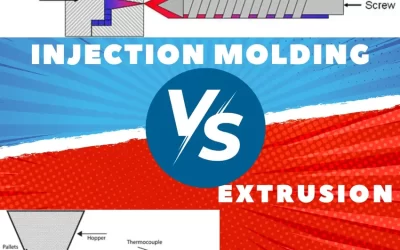
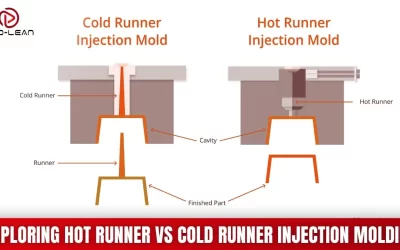
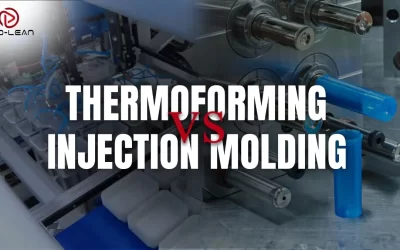
As an engineer i can feel how technical and comprehensive article on foam injection molding. Our business design molds for foaming and we are looking to partnership to manufacture them? Pls reply
Hello, Jacob. We provide mold manufacturing for foaming also. If you already have your design ready, you can upload and request the quote to detail information.
Great article! Straightforward elaboration of foam injection molding !
Buenos días
Excelente artículo, muchas gracias
¿Ustedes hacen la adaptación de las máquinas de inyección tradicional a sistemas para inyección de espumado?
¿Han tenido alguna experiencia de espumar TPU?
Gracias
Gracias por su pregunta. ¡Sí! Tenemos capacidad de procesar TPU con técnicas de moldeo. Nuestros ingenieros se comunicarán con usted para brindarle más detalles. Gracias